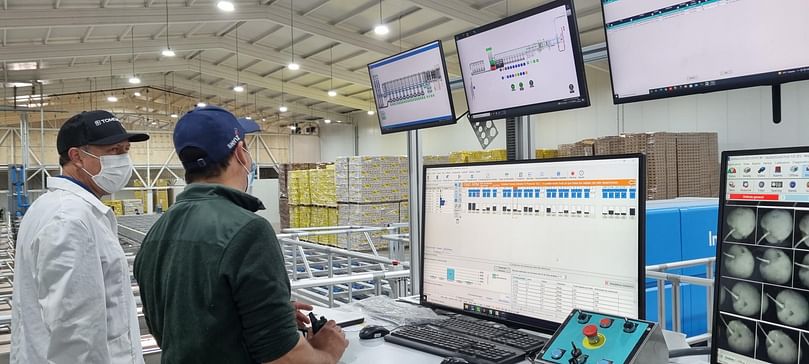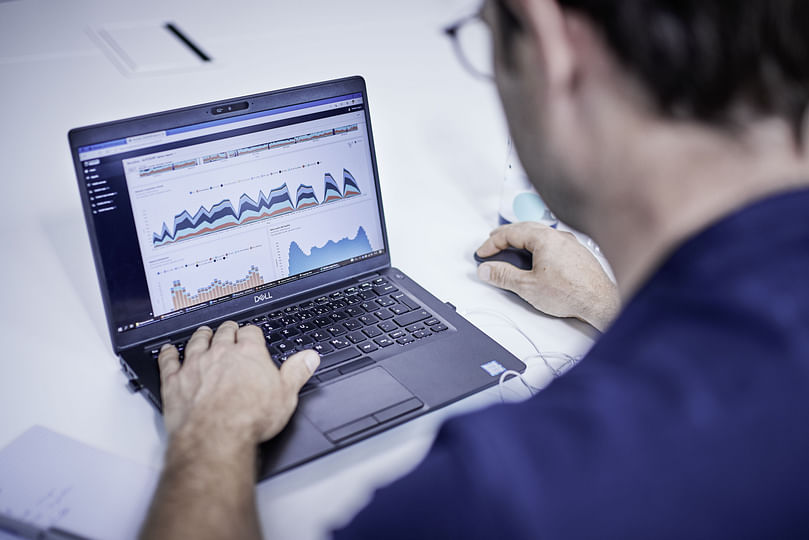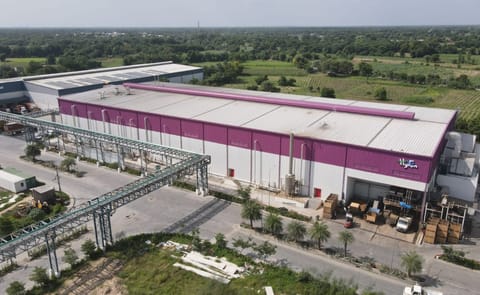Felix Flemming - Head of Digital TOMRA Sorting
Primaire tabs
Why digital transformation matters to food processors and packhouses

Though digital technologies are still young, they are already improving operational efficiencies and have the power to help improve profitability in other ways too. Felix Flemming, Head of Digital at TOMRA Food and Recycling, explains.
Some food processors and packhouses might think that "digital transformation" has nothing to do with them. That it’s something for higher-tech businesses or for a time that hasn’t yet arrived. But the reality is changing fast. In fact, digital transformation is already taking place in processing and packing and delivering competitive advantages.
But what, exactly, is digital transformation? Why is it a mistake to ignore it? And how can it improve day-to-day operational efficiencies and higher-level decision-making?
A journey to greater rewards
When we talk of digital transformation, we mean the process of using digital technologies to change the way business is done. And when we speak of digital technologies, we mean electronic tools or automated systems that generate store, and process data.
These technologies are developing so quickly that a "second wave" of digital transformation is currently sweeping through industries, bringing robotics, big data, artificial intelligence, and machine learning. These technologies are transformational because they can change business processes, business agility, customer relationships, and – of greatest immediate value to processors and packhouses – production efficiency.
There is more to digital transformation, however, than technology. It’s also a cultural change. A mindset. A willingness by businesses to recognize that they could be doing some things better and open-mindedness to digital technologies to enable the targeted improvements.
It is also important to understand that digital transformation is a journey. Because technologies and solutions are constantly evolving, progress never ceases. Many digital solutions, for example, will periodically benefit from software updates. This means that digital transformation continually helps businesses futureproof themselves.
 A moment of change
A moment of change
As the use of digital technologies widens, food processors face a moment of change. The industry is poised to take its biggest step forward since automated sorting machines replaced manual sorting. Once again, it is automated sorters that are making the leap possible.
These machines routinely collect masses of data about the product they are sorting and grading. This machine data was previously buried, but digitalization makes it accessible and useable, producing useful information about a wide range of factors such as equipment availability, machine uptime, predictive maintenance requirements, throughput, and product quality.
Product quality is of most interest to food processors because this is where their greatest operational challenges are. As well as the headaches caused by significant quality variations from one batch of infeed product to another, there can also be variations within the same batch.
Manual sampling methods can misread true batch quality because they only examine a tiny part of the product flow, sometimes missing imperfections and defects clustered in hotspots – but the sorter sees everything and reports precisely on what it finds.
First digital tools for processing
The industry leader in sorting, grading, and packing solutions, TOMRA Food, has been on its digital transformation journey for five years. Knowing that digital solutions will be a key enabler of efficient food production – and that reducing food waste is becoming increasingly important, both for economic and environmental reasons – TOMRA has committed considerable effort to build the foundations of its first digital technologies to support customers.
This has resulted in TOMRA’s Digital Operations Center; TOMRA Remote Assist for technical support; the TOMRA Visual Assist Augmented Reality tool; and the TOMRA Insight customer portal and data platform. This foundation also serves as the basis to offer artificial intelligence and deep learning solutions for TOMRA Food’s sorting and grading equipment.
TOMRA’s Digital Operations Center can remotely monitor equipment to provide customers feedback if unusual behavior is observed. Taking this one step further, TOMRA Remote Assist enables TOMRA service engineers to log into the customer’s machine remotely to provide faster technical support, eliminating or reducing downtime.
And going another step further, TOMRA Visual Assist is an easy-to-use app that enables TOMRA’s remote experts to provide specialist support to a customer or service engineer just as if they were standing in front of the customer’s machine. This makes it possible to solve broad-ranging problems of different complexity remotely.
No special equipment is needed for TOMRA Visual Assist, only a mobile phone with a camera. The TOMRA expert sends an invitation to the on-site customer technician, or one of TOMRA’s on-site Field Service Engineers, to initiate the session.
Then the app seamlessly links the technician or engineer to a call with the TOMRA expert best suited to help with the specific problem. The technician or engineer can choose to use Smart Glasses for Augmented Reality remote intervention, which leaves them hands-free for working on the machine. TOMRA Visual Assist is also a valuable training tool.
The TOMRA Insight customer portal and data platform are cloud-based and available by subscription. This automatically extracts data from sorting machines and presents it in easy-to-understand graphics.
Information about materials passing through the machines can be seen and responded to in real-time on the machine user’s touchscreen, enabling instant improvements in line efficiencies and product consistency.
More detailed data can be viewed retrospectively in reports – and by analyzing this, TOMRA and customers can work together to find further efficiency gains, not only on the line but also in the supply of raw materials. Businesses that rely on precise, objective data – rather than merely depending on experience and instinct – make better-informed operational and strategic decisions.
 Examples of efficiency gains
Examples of efficiency gains
Data leads to line improvements which may initially seem subtle, but quickly add up to savings worth having. Customer confidentiality prevents us from sharing too much detail, but without naming names, it is possible to give some examples of how these savings accumulate.
Their first example is a processing and packaging center for vegetables. This was wrestling with an incoming defect level of 42%, mostly because of vegetables that were too short to meet agreed product specifications. Over six working days, some 150 million 'short' defects were ejected from the line.
The good-in-bad ratio of rejected materials was 1.8, meaning that 18.75 million good and saleable objects (with a total weight of 1,250 tons) were thrown away. With material saleable at EUR 20 per ton, that was a EUR 25,000 (USD 27000 loss of potential revenue in just six days.
By addressing this problem through TOMRA Insight, it was possible to identify the need for a new mechanical remover before the sorter – and this reduced good-in-bad losses by 90%, increasing revenue by EUR 22,000 per week. The packhouse’s investment in TOMRA Insight paid back in 14 days.
The second example, at a fresh packer, shows how TOMRA Insight was used to check whether the belt distributor and material infeed were working optimally. Data taken over two weeks showed that one side of the belt was overloaded. Some nine million objects (with a total weight of 315,000 kilograms) were ejected during this period.
TOMRA Insight revealed that the good-in-bad ratio was 10%. To spread the load equally, TOMRA used TOMRA Insight to monitor ejections and identify required actions. The result was a reduction in good-in-bad-losses worth EUR 5,600 (USD 6,067) in two weeks, equivalent to adding EUR 145,600 (USD 157,740) to the bottom line annually.
Their third example, also at a fresh packer, shows the value gained from monitoring and reacting to incoming product quality. Here the incoming defect level was expected to be 10% but TOMRA Insight revealed it to be significantly higher, at 16%.
This information flagged up that there was a problem somewhere – perhaps an operator mistake with the sorter settings, or the machinery wasn’t cleaned well enough, or the machine had a technical problem. By looking for, finding, and solving the problem, the packhouse was able to reduce saleable raw materials losses by more than EUR 1,000 (USD 1083) during every eight-hour shift.
These examples (and many more) show how digital transformation can take processors and packhouses into a more efficient future, and that future starts right now. What businesses might initially see as a nice productivity bonus will become essential to retaining competitiveness before too long.
Some food processors and packhouses might think that "digital transformation" has nothing to do with them. That it’s something for higher-tech businesses or for a time that hasn’t yet arrived. But the reality is changing fast. In fact, digital transformation is already taking place in processing and packing and delivering competitive advantages.
But what, exactly, is digital transformation? Why is it a mistake to ignore it? And how can it improve day-to-day operational efficiencies and higher-level decision-making?
A journey to greater rewards
When we talk of digital transformation, we mean the process of using digital technologies to change the way business is done. And when we speak of digital technologies, we mean electronic tools or automated systems that generate store, and process data.
These technologies are developing so quickly that a "second wave" of digital transformation is currently sweeping through industries, bringing robotics, big data, artificial intelligence, and machine learning. These technologies are transformational because they can change business processes, business agility, customer relationships, and – of greatest immediate value to processors and packhouses – production efficiency.
There is more to digital transformation, however, than technology. It’s also a cultural change. A mindset. A willingness by businesses to recognize that they could be doing some things better and open-mindedness to digital technologies to enable the targeted improvements.
It is also important to understand that digital transformation is a journey. Because technologies and solutions are constantly evolving, progress never ceases. Many digital solutions, for example, will periodically benefit from software updates. This means that digital transformation continually helps businesses futureproof themselves.

TOMRA Food Digital Transformation
As the use of digital technologies widens, food processors face a moment of change. The industry is poised to take its biggest step forward since automated sorting machines replaced manual sorting. Once again, it is automated sorters that are making the leap possible.
These machines routinely collect masses of data about the product they are sorting and grading. This machine data was previously buried, but digitalization makes it accessible and useable, producing useful information about a wide range of factors such as equipment availability, machine uptime, predictive maintenance requirements, throughput, and product quality.
Product quality is of most interest to food processors because this is where their greatest operational challenges are. As well as the headaches caused by significant quality variations from one batch of infeed product to another, there can also be variations within the same batch.
Manual sampling methods can misread true batch quality because they only examine a tiny part of the product flow, sometimes missing imperfections and defects clustered in hotspots – but the sorter sees everything and reports precisely on what it finds.
First digital tools for processing
The industry leader in sorting, grading, and packing solutions, TOMRA Food, has been on its digital transformation journey for five years. Knowing that digital solutions will be a key enabler of efficient food production – and that reducing food waste is becoming increasingly important, both for economic and environmental reasons – TOMRA has committed considerable effort to build the foundations of its first digital technologies to support customers.
This has resulted in TOMRA’s Digital Operations Center; TOMRA Remote Assist for technical support; the TOMRA Visual Assist Augmented Reality tool; and the TOMRA Insight customer portal and data platform. This foundation also serves as the basis to offer artificial intelligence and deep learning solutions for TOMRA Food’s sorting and grading equipment.
TOMRA’s Digital Operations Center can remotely monitor equipment to provide customers feedback if unusual behavior is observed. Taking this one step further, TOMRA Remote Assist enables TOMRA service engineers to log into the customer’s machine remotely to provide faster technical support, eliminating or reducing downtime.
And going another step further, TOMRA Visual Assist is an easy-to-use app that enables TOMRA’s remote experts to provide specialist support to a customer or service engineer just as if they were standing in front of the customer’s machine. This makes it possible to solve broad-ranging problems of different complexity remotely.
No special equipment is needed for TOMRA Visual Assist, only a mobile phone with a camera. The TOMRA expert sends an invitation to the on-site customer technician, or one of TOMRA’s on-site Field Service Engineers, to initiate the session.
Then the app seamlessly links the technician or engineer to a call with the TOMRA expert best suited to help with the specific problem. The technician or engineer can choose to use Smart Glasses for Augmented Reality remote intervention, which leaves them hands-free for working on the machine. TOMRA Visual Assist is also a valuable training tool.
The TOMRA Insight customer portal and data platform are cloud-based and available by subscription. This automatically extracts data from sorting machines and presents it in easy-to-understand graphics.
Information about materials passing through the machines can be seen and responded to in real-time on the machine user’s touchscreen, enabling instant improvements in line efficiencies and product consistency.
More detailed data can be viewed retrospectively in reports – and by analyzing this, TOMRA and customers can work together to find further efficiency gains, not only on the line but also in the supply of raw materials. Businesses that rely on precise, objective data – rather than merely depending on experience and instinct – make better-informed operational and strategic decisions.

TOMRA Food Digital Transformation
Data leads to line improvements which may initially seem subtle, but quickly add up to savings worth having. Customer confidentiality prevents us from sharing too much detail, but without naming names, it is possible to give some examples of how these savings accumulate.
Their first example is a processing and packaging center for vegetables. This was wrestling with an incoming defect level of 42%, mostly because of vegetables that were too short to meet agreed product specifications. Over six working days, some 150 million 'short' defects were ejected from the line.
The good-in-bad ratio of rejected materials was 1.8, meaning that 18.75 million good and saleable objects (with a total weight of 1,250 tons) were thrown away. With material saleable at EUR 20 per ton, that was a EUR 25,000 (USD 27000 loss of potential revenue in just six days.
By addressing this problem through TOMRA Insight, it was possible to identify the need for a new mechanical remover before the sorter – and this reduced good-in-bad losses by 90%, increasing revenue by EUR 22,000 per week. The packhouse’s investment in TOMRA Insight paid back in 14 days.
The second example, at a fresh packer, shows how TOMRA Insight was used to check whether the belt distributor and material infeed were working optimally. Data taken over two weeks showed that one side of the belt was overloaded. Some nine million objects (with a total weight of 315,000 kilograms) were ejected during this period.
TOMRA Insight revealed that the good-in-bad ratio was 10%. To spread the load equally, TOMRA used TOMRA Insight to monitor ejections and identify required actions. The result was a reduction in good-in-bad-losses worth EUR 5,600 (USD 6,067) in two weeks, equivalent to adding EUR 145,600 (USD 157,740) to the bottom line annually.
Their third example, also at a fresh packer, shows the value gained from monitoring and reacting to incoming product quality. Here the incoming defect level was expected to be 10% but TOMRA Insight revealed it to be significantly higher, at 16%.
This information flagged up that there was a problem somewhere – perhaps an operator mistake with the sorter settings, or the machinery wasn’t cleaned well enough, or the machine had a technical problem. By looking for, finding, and solving the problem, the packhouse was able to reduce saleable raw materials losses by more than EUR 1,000 (USD 1083) during every eight-hour shift.
These examples (and many more) show how digital transformation can take processors and packhouses into a more efficient future, and that future starts right now. What businesses might initially see as a nice productivity bonus will become essential to retaining competitiveness before too long.
Like to receive news like this by email? Join and Subscribe!
Get the latest potato industry news straight to your WhatsApp. Join the PotatoPro WhatsApp Community!
Uitgelichte Bedrijven
Sponsored Content
Sponsored Content
Sponsored Content
Sponsored Content








